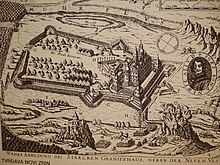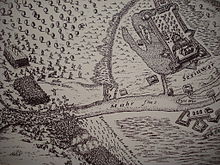Siege of Novi Zrin (1664)
| Siege of Novi Zrin (1664) | |||||||
|---|---|---|---|---|---|---|---|
| Part of the Croatian–Ottoman wars and Ottoman–Habsburg wars | |||||||
 Novi Zrin Castle, situated on the right bank of the Mura River (Muhr flus), in 1664, before it was destroyed. | |||||||
| |||||||
| Belligerents | |||||||
| Habsburg Monarchy
| Ottoman Empire
| ||||||
| Commanders and leaders | |||||||
  General Peter count of Strozzi † |   Evliya Çelebi | ||||||
| Strength | |||||||
| ~ 1,200 German, 700 Hungarian (among 30 Hajduks) and Croatian defenders | 30,000[1] | ||||||
| Casualties and losses | |||||||
| ~ 15,000 killed.[2] | ~ Unknown | ||||||
- v
- t
- e
- Mohács (1526)
- Hungarian campaign (1527–28)
- Hundred Years' Croatian–Ottoman War (1527–1593)
- Hungary (1529)
- Vienna (1529)
- Little Wars in Hungary
- (1529–1533) (1540–1547) (1551–1562) (1565–1568)
- Győr (1577)
- Bicske (1578)
- Long War (1593–1606)
- Bocskai uprising (1604–1606)
- Austro-Turkish War (1663–64)
- Great Turkish War (1683–1699)
- Austro-Turkish War (1716–1718)
- Russo-Turkish War (1735–1739)
- Austro-Turkish War (1788–91)
Mediterranean
- Cephalonia (1500)
- Balearics (1501)
- 1st Algiers (1516)
- Tlemcen (1518)
- 2nd Algiers (1519)
- 3rd Algiers (1529)
- Formentera (1529)
- Cherchell (1531)
- Coron (1533–1534)
- 1st Tunis (1534)
- 2nd Tunis (1535)
- Mahón (1535)
- Preveza (1538)
- Castelnuovo (1539)
- Girolata (1540)
- Alborán (1540)
- 4th Algiers (1541)
- Nice (1543)
- 1st Mostaganem (1543)
- Lipari (1544)
- Naples (1544)
- 2st Mostaganem (1547)
- Cullera (1550)
- Mahdia (1550)
- 1st Gozo (1551)
- Tripoli (1551)
- Ponza (1552)
- Corsica (1553–1559)
- Viste (1554)
- Béjaïa (1555)
- Oran (1556)
- Balearics (1558)
- 3rd Mostaganem (1558)
- Djerba (1560)
- Orán and Mers-el-Kébir (1563)
- 1st Peñón de Vélez de la Gomera (1563)
- Granada (1563)
- 2nd Peñón de Vélez de la Gomera (1564)
- Malta (1565)
- 3rd Tunis (1569)
- 2nd Gozo (1570)
- Lepanto (1571)
- Navarino (1572)
- 4th Tunis (1573)
- 5th Tunis (1574)
- Cadaqués (1575)
- Lanzarote (1586)
- Chios (1599)
- Hammamet (1605)
- Cape Corvo (1613)
- Malta (1614)
- Cape Celidonia (1616)
- Constantinople (1616)


The siege of Novi Zrin (New Zrin Castle); Croatian: Utvrda Novi Zrin; Hungarian: Új-Zrínyivár; Turkish: Zerinvar) in June/July 1664 was last of the military conflicts between the Croatian forces (with allies) led by Nikola Zrinski, Ban (viceroy) of Croatia, and the Ottoman army commanded by Köprülü Fazıl Ahmed Pasha, Grand Vizier, dealing with possession of Novi Zrin Castle, defended by Croats, situated on the bank and marshy islands of Mura River, near the border line between northern Croatia and southwestern part of Hungary, at the time occupied by the Ottomans. The battle resulted in destruction[1] of the castle, and retreat of the Croatian crew, which was forced to withdraw to safer territory of inland Croatia.
Historical background
Despite local skirmishes and battles along the Ottoman border with Croatia, Hungary and Transylvania at the beginning of the 1660s, there was a period of unstable and insecure (tacit assumption) temporary peace between the Habsburg monarchy and the Ottoman Empire. It seemed that both sides wanted to keep it; however, Leopold I of Habsburg, twenty-year-old inexperienced Emperor, under strong influence of his advisors, feared Ottoman campaign towards Vienna and possible siege of the Austrian capital, so he kept the majority of his military forces close to Vienna.
At the same time, Nikola Zrinski, Croatian ban and brave and skillful warrior, well-known all over Europe, demanded support from the Viennese court to consolidate and reinforce the border line in northern Croatia, by constructing new fortifications that would parry and neutralize the Ottoman threat from Kanije Eyalet in the occupied southwestern Hungary, but with no success. In 1661 Zrinski started construction of new stronghold - Novi Zrin Castle, on his own, at the confluence of the Mura River with the Drava, finishing it during 1662. Since then, the castle was attacked several times by the Ottomans, especially in 1663, but its defence was solid and successful.
Siege
At the beginning of June 1664 a large Ottoman army, numbering up to 100,000 men (some sources mention even much more), including around 40,000 Ottoman and 30,000 Tatar fighters, led personally by the Grand Vizier Köprülü, was moving from Constantinople to the northwest and approaching Novi Zrin (later to fight in the Battle of Saint Gotthard on 1 August 1664). The defenders of Novi Zrin consisted mostly of Croatian and German soldiers (around 3,000 men in total), while the majority of the Habsburg army (30,000 men), encamped near Saint Gotthard, awaited the outcome of Novi Zrin battle. As the siege of Novi Zrin was ongoing, Crimean Tatars led by kahn's son Ahmed Giray raided the Croatian countryside, which according to Evliya Celeby's Seyahatnâme resulted in sack of Krapina.[3]
On 5 June 1664 Köprülü ordered siege and continuous attacks upon the castle. After a few weeks of fighting, with exhausted defenders receiving only insignificant reinforcements from the Emperor's headquarters, the Turks managed to dig lagums, or tunnels, below the bastions and ignited gunpowder to blow them up. On 7 July 1664 the strong explosions destroyed parts of the walls, making big holes. Aggressors consequently rushed and penetrated into the castle.
The surviving and enormously outnumbered Croatian defenders were forced to withdraw from the castle and abandon the Mura River area. Ottoman commanders gave the order to their soldiers to destroy Novi Zrin completely to the ground and then marched their army northwards, first towards Kanije and then towards Saint Gotthard.
Aftermath
The destruction of Novi Zrin, together with a little bit later (on 10 August 1664) signed the Peace of Vasvár, that was recognized by many Croatian and Hungarian magnates like Zrinski as unfavourable and shameful. Their tension with the Habsburg government lead to the Zrinski–Frankopan conspiracy. Later in the same year Zrinski died, allegedly killed by a wild boar, but the rest of magnates continued the conspiracy, which ended tragically in 1671.
Novi Zrin was never rebuilt.[1] Today there is only a memorial obelisk on the place where the castle once was.
See also
- Croatian–Ottoman Wars
- Austro-Turkish War (1663–64)
- Ottoman–Habsburg wars
- Ottoman wars in Europe
References
- ^ a b c Feletar 2011, p. 81
- ^ Vincent Mignot ,1787
- ^ Çelebi, Evliya (1996). Putopis: odlomci o jugoslavenskim zemljama (in Bosnian). Sarajevo: Sarajevo - Publishing. pp. 503–509.
Sources
- Feletar, Dragutin (September 2011). "Legradska kapetanija u obrani od Osmanlija s posebnim osvrtom na Novi Zrin" [Role of the Legrad Military District in the Defence against the Ottoman Empire - Special Emphasis on Novi Zrin]. Rad Hrvatske Akademije Znanosti i Umjetnosti (in Croatian) (510=48). Zagreb: The Croatian Academy of Sciences and Arts: 47–81. ISSN 1330-0768. 48=510(2011):47-81.
External links
- Siege of Novi Zrin lasted from early June until early July 1664
- Rise and fall of New Zrin Castle, including final battle during June and July 1664
- Novi Zrin fort was destroyed by Turks just several years after it was built
- Novi Zrin memorial obelisk
- General Strozzi biography














